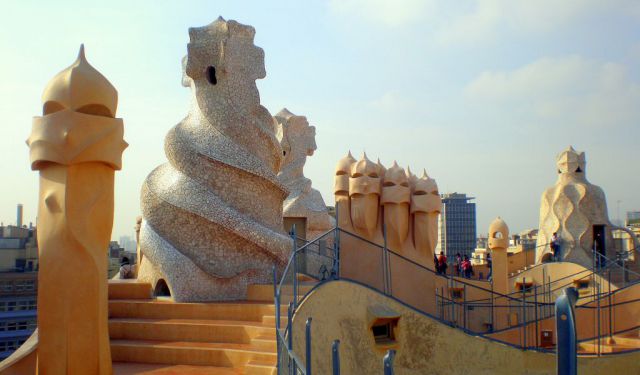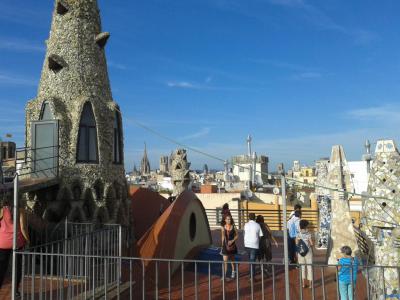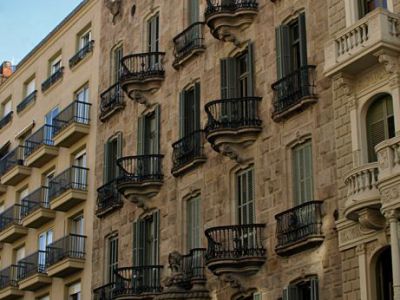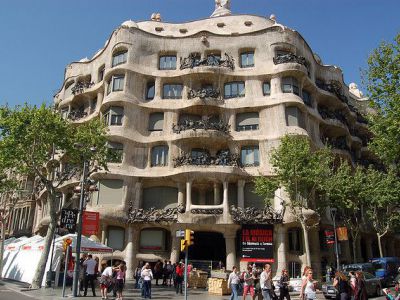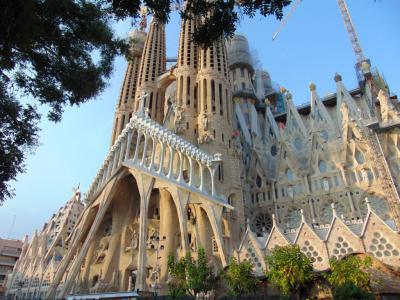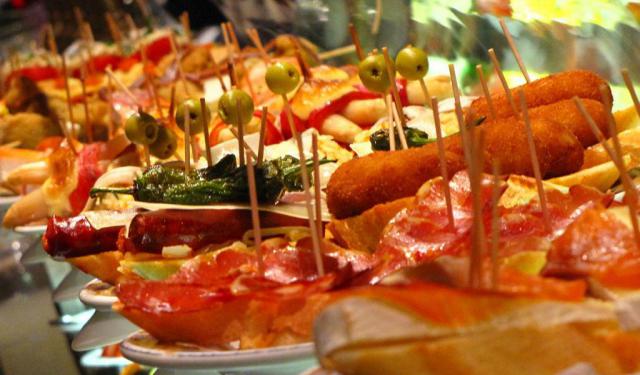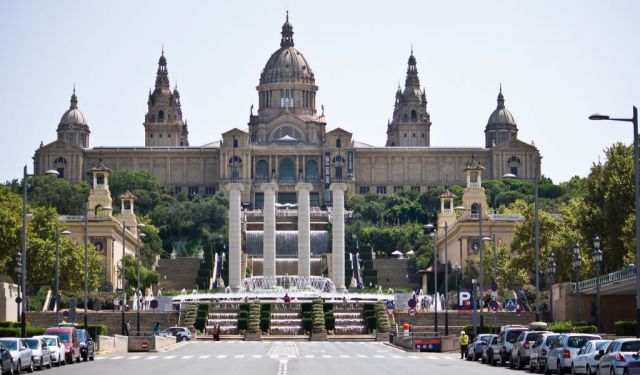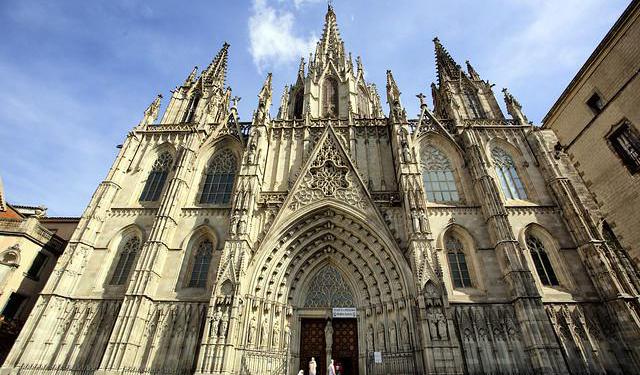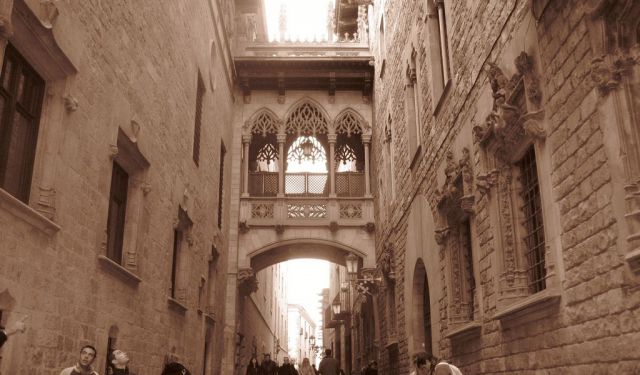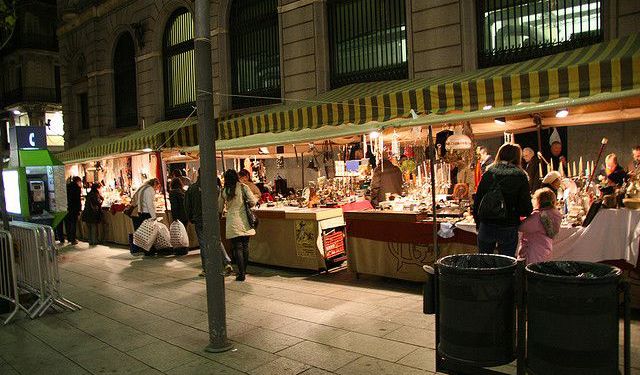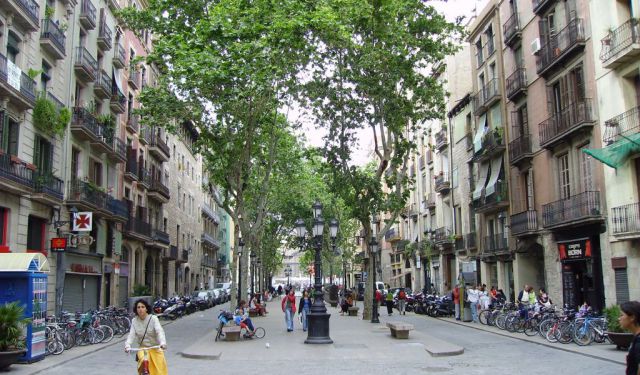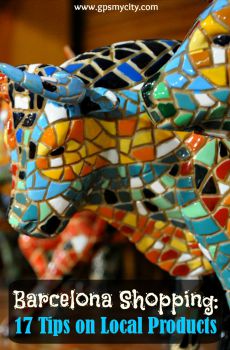Audio Guide: Antoni Gaudí's Masterpieces Walking Tour (Self Guided), Barcelona
Antoni Gaudi, a seminal figure in the Catalan Modernism movement, is one of the top architects of the 20th century. The unique technique and use of natural forms in his works stand out from the pack and have left an indelible mark on the face of Barcelona.
Our journey through Gaudi's Barcelona begins at the Güell Palace, by far the most budget-friendly of his projects. Located near La Rambla, this palace showcases Gaudi's blend of opulence and functionality, reflecting his Gothic influences and innovative structural solutions. Notably, its design allows much to be admired from the outside, including its façade and distinctive rooftop, without any visual barriers. Constructed in 1885, the mansion features a phoenix emblematic of the Catalan Renaissance and brightly colored ceramic and tile chimney stacks visible from the street.
Our next stop is the Calvet House. Built in 1899 for a textile manufacturer, it represents one of Gaudi's more conservative designs. Despite its symmetry and balance, essential for a business residence, the building incorporates distinctly modernist elements, hinting at the whimsical styles that would later become synonymous with Gaudi's architectural legacy.
Other notable sites, the Batlló and Milà houses, exemplify Gaudi's unique style through their shared vocabulary. The Batlló House, with its façade resembling swirling colors and shapes evoking bones, creatively represents Saint George and the dragon, complete with a dragon-back-shaped roof. Meanwhile, the Milà House, colloquially known as “La Pedrera” (or Stone Quarry) for its rough exterior, features a striking undulating stone façade and twisted iron sculptures, celebrating Gaudi's pioneering use of organic forms.
Finally, La Sagrada Familia, Antoni Gaudí's most famous masterwork, is a monumental basilica that has been under construction since 1882. Barcelona's premier attraction celebrated for its celestial-inspired architecture, it is slated for completion in 2026 to mark the centennial anniversary of Gaudi's death.
To fully appreciate the genius of Antoni Gaudi, one must experience his work firsthand. Follow this self-guided tour of Gaudi's Barcelona and let yourself be captivated by its architectural treasures. Each visit promises a glimpse into the mind of a visionary.
Our journey through Gaudi's Barcelona begins at the Güell Palace, by far the most budget-friendly of his projects. Located near La Rambla, this palace showcases Gaudi's blend of opulence and functionality, reflecting his Gothic influences and innovative structural solutions. Notably, its design allows much to be admired from the outside, including its façade and distinctive rooftop, without any visual barriers. Constructed in 1885, the mansion features a phoenix emblematic of the Catalan Renaissance and brightly colored ceramic and tile chimney stacks visible from the street.
Our next stop is the Calvet House. Built in 1899 for a textile manufacturer, it represents one of Gaudi's more conservative designs. Despite its symmetry and balance, essential for a business residence, the building incorporates distinctly modernist elements, hinting at the whimsical styles that would later become synonymous with Gaudi's architectural legacy.
Other notable sites, the Batlló and Milà houses, exemplify Gaudi's unique style through their shared vocabulary. The Batlló House, with its façade resembling swirling colors and shapes evoking bones, creatively represents Saint George and the dragon, complete with a dragon-back-shaped roof. Meanwhile, the Milà House, colloquially known as “La Pedrera” (or Stone Quarry) for its rough exterior, features a striking undulating stone façade and twisted iron sculptures, celebrating Gaudi's pioneering use of organic forms.
Finally, La Sagrada Familia, Antoni Gaudí's most famous masterwork, is a monumental basilica that has been under construction since 1882. Barcelona's premier attraction celebrated for its celestial-inspired architecture, it is slated for completion in 2026 to mark the centennial anniversary of Gaudi's death.
To fully appreciate the genius of Antoni Gaudi, one must experience his work firsthand. Follow this self-guided tour of Gaudi's Barcelona and let yourself be captivated by its architectural treasures. Each visit promises a glimpse into the mind of a visionary.
How it works: Download the app "GPSmyCity: Walks in 1K+ Cities" from Apple App Store or Google Play Store to your mobile phone or tablet. The app turns your mobile device into a personal tour guide and its built-in GPS navigation functions guide you from one tour stop to next. The app works offline, so no data plan is needed when traveling abroad.
Antoni Gaudí's Masterpieces Walking Tour Map
Guide Name: Antoni Gaudí's Masterpieces Walking Tour
Guide Location: Spain » Barcelona (See other walking tours in Barcelona)
Guide Type: Self-guided Walking Tour (Sightseeing)
# of Attractions: 5
Tour Duration: 2 Hour(s)
Travel Distance: 4.6 Km or 2.9 Miles
Author: DanaOffice
Sight(s) Featured in This Guide:
Guide Location: Spain » Barcelona (See other walking tours in Barcelona)
Guide Type: Self-guided Walking Tour (Sightseeing)
# of Attractions: 5
Tour Duration: 2 Hour(s)
Travel Distance: 4.6 Km or 2.9 Miles
Author: DanaOffice
Sight(s) Featured in This Guide:
- Palau Guell (Guell Palace)
- Casa Calvet (Calvet House)
- Casa Batllo (Batllo House)
- Casa Mila (Mila House)
- La Sagrada Familia (Basilica of the Holy Family)
1) Palau Guell (Guell Palace) (must see)
Nestled in a discreet corner off the bustling La Rambla, the Güell Palace is an inaugural masterpiece of the architect Antoni Gaudí in Barcelona, which swiftly propelled him to international acclaim.
Now part of the UNESCO World Heritage Site called the "Works of Antoni Gaudí", this mansion was built between 1886 and 1888 for the industrial tycoon and Gaudí's lifelong patron, Eusebi Güell. The building showcases Gaudí's innovative use of iron supports as decorative elements, featuring twisted columns, arches, and intricate ceilings, topped with a whimsical array of tiled chimneys on the roof terrace.
Designed for high-society gatherings, the home’s central room has a tall ceiling, soaring three floors high, with a cupola. At night, to produce the appearance of a starlit sky, lanterns were hung from the outside through the small holes near the top. Arriving in horse-drawn carriages, guests entered the property through grand oval gates adorned with ironwork resembling seaweed. Horses were taken to a livery stable in the basement, while guests ascended to the receiving room. The walls and ceilings of this room contain discreet observation holes, allowing the owner to view guests from above before making an entrance.
With no budget constraints, Gaudí utilized the finest materials and craftsmanship to create a space that blends function and artistry seamlessly. This residence served as a preview of Gaudí’s future architectural innovations and his flair for combining structural elements with imaginative design.
Being slightly tucked away from the renowned La Rambla promenade, this lesser-known gem attracts fewer tourists, while offering a delightful opportunity to admire Gaudí's work in the charming old quarter of the city.
Tip:
The building's highlight is the rooftop terrace and its colorful chimneys adorned with mosaic and broken tiles. Note: on a rainy day, the rooftop may be closed, so it's advisable to check in advance the weather forecast to ensure a pleasant visit.
Now part of the UNESCO World Heritage Site called the "Works of Antoni Gaudí", this mansion was built between 1886 and 1888 for the industrial tycoon and Gaudí's lifelong patron, Eusebi Güell. The building showcases Gaudí's innovative use of iron supports as decorative elements, featuring twisted columns, arches, and intricate ceilings, topped with a whimsical array of tiled chimneys on the roof terrace.
Designed for high-society gatherings, the home’s central room has a tall ceiling, soaring three floors high, with a cupola. At night, to produce the appearance of a starlit sky, lanterns were hung from the outside through the small holes near the top. Arriving in horse-drawn carriages, guests entered the property through grand oval gates adorned with ironwork resembling seaweed. Horses were taken to a livery stable in the basement, while guests ascended to the receiving room. The walls and ceilings of this room contain discreet observation holes, allowing the owner to view guests from above before making an entrance.
With no budget constraints, Gaudí utilized the finest materials and craftsmanship to create a space that blends function and artistry seamlessly. This residence served as a preview of Gaudí’s future architectural innovations and his flair for combining structural elements with imaginative design.
Being slightly tucked away from the renowned La Rambla promenade, this lesser-known gem attracts fewer tourists, while offering a delightful opportunity to admire Gaudí's work in the charming old quarter of the city.
Tip:
The building's highlight is the rooftop terrace and its colorful chimneys adorned with mosaic and broken tiles. Note: on a rainy day, the rooftop may be closed, so it's advisable to check in advance the weather forecast to ensure a pleasant visit.
2) Casa Calvet (Calvet House)
Calvet House, designed by Antoni Gaudí, presents a more conventional project compared to his more flamboyant counterparts like Batlló and Milà houses. This townhouse, nestled in the sophisticated Eixample district of Barcelona, was crafted between 1898 and 1900 for the textile mogul Pere Calvet. It combines commercial spaces on the lower floors with private residences above. This structure is noted for its symmetry and balanced composition, which were necessary due to its location between pre-existing buildings.
Despite its traditional form, Calvet House is punctuated with Gaudí's signature Modernista elements. These include a dramatic baroque oriel at the entrance and whimsically detailed columns shaped like bobbins, reflecting the owner’s textile business. The facade, made of Montjuïc sandstone, is adorned with baroque scroll gables and lacks Gaudí's usual vibrant ceramics. However, it compensates with rich Art Nouveau details throughout its interiors, such as intricately designed door handles, furniture, and a striking glass-and-wood elevator.
Key symbolic elements on the facade include the stylized letter "C" for Calvet and a cypress tree that symbolizes hospitality. The facade also features alternating protruding and shallow balconies, with mushrooms over the central oriel hinting at the owner's mycological interests. The building’s decor integrates personal and local references, such as the busts of Saint Peter, the patron saint of the owner, and Saint Genis of Arles and Rome, linked to the Calvet family's hometown of Vilassar. These personal touches are further exemplified by three sculpted heads at the top of the facade, representing Pere Calvet's father and the family’s patron saints.
The ground floor, which once housed Calvet's textile offices, is now the Calvet House restaurant, open to visitors and showcasing the building's opulent Moderniste decor. This architectural gem not only reflects Gaudí's adaptability to urban constraints but also his deep engagement with personalized architectural expressions. Between 1899 and 1906, the building was recognized along with other modernist landmarks in Barcelona, such as Lleó Morera and Trinxet houses, receiving accolades for its artistic contribution to the city's landscape.
Despite its traditional form, Calvet House is punctuated with Gaudí's signature Modernista elements. These include a dramatic baroque oriel at the entrance and whimsically detailed columns shaped like bobbins, reflecting the owner’s textile business. The facade, made of Montjuïc sandstone, is adorned with baroque scroll gables and lacks Gaudí's usual vibrant ceramics. However, it compensates with rich Art Nouveau details throughout its interiors, such as intricately designed door handles, furniture, and a striking glass-and-wood elevator.
Key symbolic elements on the facade include the stylized letter "C" for Calvet and a cypress tree that symbolizes hospitality. The facade also features alternating protruding and shallow balconies, with mushrooms over the central oriel hinting at the owner's mycological interests. The building’s decor integrates personal and local references, such as the busts of Saint Peter, the patron saint of the owner, and Saint Genis of Arles and Rome, linked to the Calvet family's hometown of Vilassar. These personal touches are further exemplified by three sculpted heads at the top of the facade, representing Pere Calvet's father and the family’s patron saints.
The ground floor, which once housed Calvet's textile offices, is now the Calvet House restaurant, open to visitors and showcasing the building's opulent Moderniste decor. This architectural gem not only reflects Gaudí's adaptability to urban constraints but also his deep engagement with personalized architectural expressions. Between 1899 and 1906, the building was recognized along with other modernist landmarks in Barcelona, such as Lleó Morera and Trinxet houses, receiving accolades for its artistic contribution to the city's landscape.
3) Casa Batllo (Batllo House) (must see)
Batlló House, located in the heart of Barcelona's prestigious Gràcia Boulevard, is one of Gaudí’s most celebrated architectural masterpieces. Originally built in 1877 by Lluís Sala Sánchez, the building underwent a radical transformation in 1904 when textile industrialist Josep Batlló hired Antoni Gaudí to renovate it. Gaudí expanded the structure, creating new floors and adding his signature audacious design, which turned this previously unremarkable building into a landmark of Modernist architecture.
Batlló House is often referred to as the "House of Bones" due to its skeletal-like balconies and organic forms. Another local name for it is the "House of the Dragon," as its arched roof, covered in colorful mosaic tiles, is said to resemble the spine of a dragon. This symbolism aligns with the legend of Saint George (Catalonia’s patron saint), whose lance is represented by the turret and cross atop the roof.
The building's façade is divided into three sections and adorned with vibrant broken ceramic tiles in shades transitioning from orange to greenish-blue. Gaudí’s use of curves, irregular windows, and sculpted stonework avoids straight lines, enhancing the structure’s flowing, dynamic feel. Inside, the loft space, with its catenary arches, imitates a ribcage, while the central atrium features blue tiles that create an underwater-like light distribution.
The rooftop is a highlight of Batlló House, with its chimneys resembling twisted, tiled sculptures. The entire structure integrates symbolism and decorative elements that showcase Gaudí’s innovative approach to form and function. After the Batlló family left in the 1950s, the house changed ownership several times and was refurbished before becoming a venue for events in 1995. In 2005, Batlló House was designated a UNESCO World Heritage Site, cementing its status as a masterpiece of modernist architecture.
Tip:
For a fee, you can have your photo taken on the small balcony at the front of the building (as you descend from the rooftop), receiving both a printed copy and an electronic version for a memorable keepsake.
Batlló House is often referred to as the "House of Bones" due to its skeletal-like balconies and organic forms. Another local name for it is the "House of the Dragon," as its arched roof, covered in colorful mosaic tiles, is said to resemble the spine of a dragon. This symbolism aligns with the legend of Saint George (Catalonia’s patron saint), whose lance is represented by the turret and cross atop the roof.
The building's façade is divided into three sections and adorned with vibrant broken ceramic tiles in shades transitioning from orange to greenish-blue. Gaudí’s use of curves, irregular windows, and sculpted stonework avoids straight lines, enhancing the structure’s flowing, dynamic feel. Inside, the loft space, with its catenary arches, imitates a ribcage, while the central atrium features blue tiles that create an underwater-like light distribution.
The rooftop is a highlight of Batlló House, with its chimneys resembling twisted, tiled sculptures. The entire structure integrates symbolism and decorative elements that showcase Gaudí’s innovative approach to form and function. After the Batlló family left in the 1950s, the house changed ownership several times and was refurbished before becoming a venue for events in 1995. In 2005, Batlló House was designated a UNESCO World Heritage Site, cementing its status as a masterpiece of modernist architecture.
Tip:
For a fee, you can have your photo taken on the small balcony at the front of the building (as you descend from the rooftop), receiving both a printed copy and an electronic version for a memorable keepsake.
4) Casa Mila (Mila House) (must see)
Milà House, commonly known as La Pedrera ("The Stone Quarry"), is a modernist masterpiece designed by Antoni Gaudí and located on Gràcia Boulevard in Barcelona. Constructed between 1906 and 1912 for Roser Segimón and her husband Pere Milà, its nickname derives from its stony, fortress-like appearance. Gaudí, however, viewed the structure as a living body, with columns as bones and stone as flesh.
The building’s wavy stone façade and wrought iron balconies were highly controversial at the time for their unconventional design. Gaudí introduced several innovative features, such as a self-supporting façade, free-plan floors, and an underground garage. The structure, inspired by natural forms, incorporates curved surfaces and catenary arches in the attic, while its layout around courtyards ensures natural light reaches all nine stories. The distinctive roof terrace, with sculptural chimneys and skylights, offers panoramic views of the city and is known as "the garden of warriors."
Following initial criticism and conflicts with Roser Segimón over the aesthetic details, Milà House has undergone significant changes throughout its history. Originally intended as a private residence, it was later sold, converted into apartments, and eventually fell into disrepair. It was restored in the 1980s, regaining its original colors and features, and was declared a UNESCO World Heritage Site in 1984.
Today, Milà House serves as a cultural center, featuring an exhibition on Gaudí’s life and work, showcasing models, drawings, and photographs of his architectural creations. The fourth floor showcases a recreation of an early 20th-century apartment, giving insight into the lifestyle of affluent families of that period.
Milà House is a testament to Gaudí’s architectural innovation and his challenge to conventional design norms. Over the years, it has inspired many modern buildings worldwide, including the Guggenheim Museum in New York City and Disney Concert Hall in Los Angeles. Today, it stands as one of Barcelona’s most iconic landmarks, attracting visitors from around the world to experience Gaudí’s visionary creativity firsthand.
Tip:
To avoid waiting in line, try and book your ticket online in advance and, if possible, visit around sunset when the lights are on, allowing you to experience the surreal audiovisual show. During the summer months, jazz and flamenco concerts are often held here, which is quite a treat as well.
The building’s wavy stone façade and wrought iron balconies were highly controversial at the time for their unconventional design. Gaudí introduced several innovative features, such as a self-supporting façade, free-plan floors, and an underground garage. The structure, inspired by natural forms, incorporates curved surfaces and catenary arches in the attic, while its layout around courtyards ensures natural light reaches all nine stories. The distinctive roof terrace, with sculptural chimneys and skylights, offers panoramic views of the city and is known as "the garden of warriors."
Following initial criticism and conflicts with Roser Segimón over the aesthetic details, Milà House has undergone significant changes throughout its history. Originally intended as a private residence, it was later sold, converted into apartments, and eventually fell into disrepair. It was restored in the 1980s, regaining its original colors and features, and was declared a UNESCO World Heritage Site in 1984.
Today, Milà House serves as a cultural center, featuring an exhibition on Gaudí’s life and work, showcasing models, drawings, and photographs of his architectural creations. The fourth floor showcases a recreation of an early 20th-century apartment, giving insight into the lifestyle of affluent families of that period.
Milà House is a testament to Gaudí’s architectural innovation and his challenge to conventional design norms. Over the years, it has inspired many modern buildings worldwide, including the Guggenheim Museum in New York City and Disney Concert Hall in Los Angeles. Today, it stands as one of Barcelona’s most iconic landmarks, attracting visitors from around the world to experience Gaudí’s visionary creativity firsthand.
Tip:
To avoid waiting in line, try and book your ticket online in advance and, if possible, visit around sunset when the lights are on, allowing you to experience the surreal audiovisual show. During the summer months, jazz and flamenco concerts are often held here, which is quite a treat as well.
5) La Sagrada Familia (Basilica of the Holy Family) (must see)
The Basilica and Expiatory Temple of the Holy Family, commonly known as La Sagrada Família, is an iconic, unfinished church in Barcelona designed by Catalan Modernist architect Antoni Gaudí. Construction began in 1882 with architect Francisco de Paula del Villar, who envisioned a Gothic revival-style church. Upon taking over the project in 1883, Gaudí transformed the design into a unique blend of Gothic and Art Nouveau styles. Despite spending an impressive 43 years of his life designing this monument, by the time of Gaudí's death in 1926, only 15-25% of the basilica had been completed.
Relied on private donations, the construction has faced multiple interruptions like the Spanish Civil War in the 1930s. Modern technology has sped up the progress, however, and the church is now set to be finished by 2026, with further decorative work expected until 2034.
The Sagrada Família features eighteen planned spires symbolizing the Twelve Apostles, four Evangelists, the Virgin Mary, and Jesus Christ. Thirteen spires have been completed so far. The basilica’s three façades-the Nativity, Passion, and Glory-each represent different phases of Christ’s life and showcase a blend of naturalistic and minimalist styles.
The interior, designed as a Latin cross with five aisles, showcases Gaudí’s mastery of geometry and organic forms. The central nave vaults reach 45 meters, while the apse vault extends to 75 meters. The columns, which change shape as they rise, contribute to the basilica’s distinct look. Gaudí's use of hyperboloid structures and ruled surfaces enhances both the stability and aesthetic appeal of the building.
As of 2017, visitors can book tickets online to access various parts of the basilica, including the Nave, Crypt, and museum, as well as the Passion and Nativity steeples. A visit to the steeples includes a challenging descent through a narrow spiral staircase of over 300 steps. Also of note is the museum below, offering a wealth of information, including audiovisual presentations about the Sagrada Família project's history, plans, and Gaudí himself. You may also want to visit the small school built by Antoni Gaudí for the children of the construction workers right on the site.
Once completed, the Sagrada Família is to become the tallest church in the world and a lasting testament to Gaudí’s vision of blending architecture, nature, and spirituality.
Tip:
Please note that children under 6 are not permitted to ascend the towers; some adults may find the spiral staircase challenging too. If you decide to climb, ask the staff for directions to the "backside elevator", as it is usually less crowded.
Relied on private donations, the construction has faced multiple interruptions like the Spanish Civil War in the 1930s. Modern technology has sped up the progress, however, and the church is now set to be finished by 2026, with further decorative work expected until 2034.
The Sagrada Família features eighteen planned spires symbolizing the Twelve Apostles, four Evangelists, the Virgin Mary, and Jesus Christ. Thirteen spires have been completed so far. The basilica’s three façades-the Nativity, Passion, and Glory-each represent different phases of Christ’s life and showcase a blend of naturalistic and minimalist styles.
The interior, designed as a Latin cross with five aisles, showcases Gaudí’s mastery of geometry and organic forms. The central nave vaults reach 45 meters, while the apse vault extends to 75 meters. The columns, which change shape as they rise, contribute to the basilica’s distinct look. Gaudí's use of hyperboloid structures and ruled surfaces enhances both the stability and aesthetic appeal of the building.
As of 2017, visitors can book tickets online to access various parts of the basilica, including the Nave, Crypt, and museum, as well as the Passion and Nativity steeples. A visit to the steeples includes a challenging descent through a narrow spiral staircase of over 300 steps. Also of note is the museum below, offering a wealth of information, including audiovisual presentations about the Sagrada Família project's history, plans, and Gaudí himself. You may also want to visit the small school built by Antoni Gaudí for the children of the construction workers right on the site.
Once completed, the Sagrada Família is to become the tallest church in the world and a lasting testament to Gaudí’s vision of blending architecture, nature, and spirituality.
Tip:
Please note that children under 6 are not permitted to ascend the towers; some adults may find the spiral staircase challenging too. If you decide to climb, ask the staff for directions to the "backside elevator", as it is usually less crowded.
Walking Tours in Barcelona, Spain
Create Your Own Walk in Barcelona
Creating your own self-guided walk in Barcelona is easy and fun. Choose the city attractions that you want to see and a walk route map will be created just for you. You can even set your hotel as the start point of the walk.
Barcelona Food Tasting Walking Tour
No one should visit Barcelona without making an attempt to get acquainted with some of Spain’s best food – Catalan food. An abundance of fresh fish and superb meat, a plethora of great vegetables, plus local inventiveness, have produced a very diverse, distinctive and delicious cuisine, including the famous (and trendy) tapas dishes.
Follow this self-guided walk to treat your taste buds in... view more
Tour Duration: 2 Hour(s)
Travel Distance: 2.9 Km or 1.8 Miles
Follow this self-guided walk to treat your taste buds in... view more
Tour Duration: 2 Hour(s)
Travel Distance: 2.9 Km or 1.8 Miles
Montjuic Walking Tour
Montjuic is a hill in Barcelona which offers a variety of great attractions of historic, cultural, and architectural value. Here, you can watch a spectacular water show at the Magic Fountain of Montjuic, visit the place where matadors faced the bulls in the past, and explore the ancient Montjuic Castle with its breathtaking views.
A convenient start point, Placa d'Espanya is the second... view more
Tour Duration: 3 Hour(s)
Travel Distance: 5.0 Km or 3.1 Miles
A convenient start point, Placa d'Espanya is the second... view more
Tour Duration: 3 Hour(s)
Travel Distance: 5.0 Km or 3.1 Miles
Barcelona Introduction Walking Tour
According to legend, Barcelona was founded by the mythological Greek hero Hercules on one of his expeditions, when a storm hit his boats. The first eight boats managed to escape without damage, but the ninth was lost at sea. Hercules found his lost friends some days later on the coast, all safe and sound. The boat's crew, taken by the beauty of the coastal landscape, decided to stay. On that... view more
Tour Duration: 3 Hour(s)
Travel Distance: 5.7 Km or 3.5 Miles
Tour Duration: 3 Hour(s)
Travel Distance: 5.7 Km or 3.5 Miles
Gothic Quarter Walking Tour
A walk through the Gothic Quarter – Barcelona’s oldest part, dating from the Roman era – is like a journey through time. The typical Roman grid plan is still visible in the quarter's layout. Only a few roads are open for car traffic, so there is little in the way of enjoying the narrow, atmospheric streets filled with high-quality architecture, numerous boutiques, and coffee shops.... view more
Tour Duration: 2 Hour(s)
Travel Distance: 1.8 Km or 1.1 Miles
Tour Duration: 2 Hour(s)
Travel Distance: 1.8 Km or 1.1 Miles
Barcelona Shopping Walk
A long-time prime cultural destination, Barcelona is also en route to becoming one of Europe's top shopping spots. Each new day, fashionable designer stores, from well-known international brands to local start-ups, are filling the city streets. If you're a fan of shopping, you're in for a treat when visiting this beautiful city. Here are some of the most popular shopping locations... view more
Tour Duration: 2 Hour(s)
Travel Distance: 3.4 Km or 2.1 Miles
Tour Duration: 2 Hour(s)
Travel Distance: 3.4 Km or 2.1 Miles
La Ribera Walking Tour
La Ribera is a culturally rich, historic area of Barcelona’s Old Town; somewhat less touristy than the Gothic Quarter (which one should really visit as well) and quite unspoiled, authentic and pretty. Centuries ago, it was a very well-to-do neighborhood inhabited by aristocrats, merchants, wealthy sailors, and Jewish money-lenders. Today, it is regarded as the Soho of Barcelona – a popular... view more
Tour Duration: 2 Hour(s)
Travel Distance: 2.8 Km or 1.7 Miles
Tour Duration: 2 Hour(s)
Travel Distance: 2.8 Km or 1.7 Miles
Useful Travel Guides for Planning Your Trip
Barcelona Souvenir Shopping: 17 Uniquely Spanish Things to Buy
Spain, in general, and Barcelona, in particular, are a treasure trove of all things exciting. Set your foot in Barcelona and you'll be spoiled for the choice of things worth trying and taking home. Before your head starts spinning, check this guide out to put yourself in the right...
Top 10 Spanish Foods and Drinks to Try in Barcelona
In the countries like Spain, food is a national heritage and cultural attraction in its own right. The latter is even more true of Catalonia in general and Barcelona in particular. Presented here are the 10 staples of Catalan food tradition, missing which would be a gastronomical...
The Most Popular Cities
/ view all
